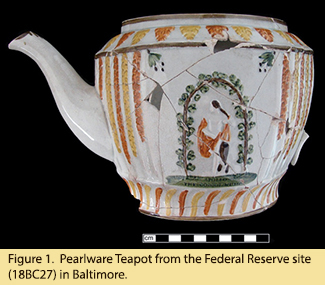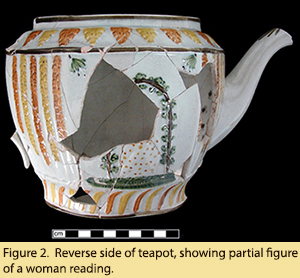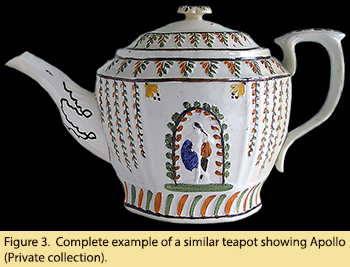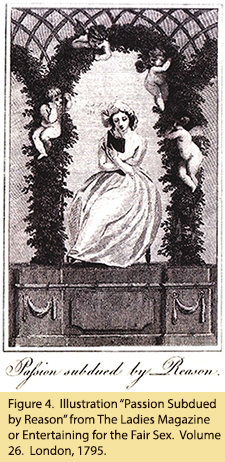July 2016
By Patricia Samford, MAC Lab Director
 This unusual teapot (Figure 1) made a brief visit to the Maryland Archaeological Conservation Lab in May of 2016 as part of a collection of artifacts from the Federal Reserve Site (18BC27) in Baltimore. While the lab curates most of the site’s artifacts, a number of items from the 1980 excavation in the Old Otterbein neighborhood are owned by the Federal Reserve Bank of Richmond. The bank’s collection visited the lab for cataloging and photography in 2016 and many interesting pieces were recorded.
This unusual teapot (Figure 1) made a brief visit to the Maryland Archaeological Conservation Lab in May of 2016 as part of a collection of artifacts from the Federal Reserve Site (18BC27) in Baltimore. While the lab curates most of the site’s artifacts, a number of items from the 1980 excavation in the Old Otterbein neighborhood are owned by the Federal Reserve Bank of Richmond. The bank’s collection visited the lab for cataloging and photography in 2016 and many interesting pieces were recorded.
The drinking and serving of tea in colonial America was accompanied by a number of specialized objects and a set of ritualized behaviors. The ceremony of tea consumption was associated primarily with women at this time. Teapots are a common find on eighteenth- and nineteenth-century archaeological sites in North America, but if one considers this particular  teapot as part of the feminine sphere, it becomes much more than just a vessel for holding a hot beverage.
teapot as part of the feminine sphere, it becomes much more than just a vessel for holding a hot beverage.
The earthenware teapot is molded with two human figures. One side shows a draped male figure and the impressed inscription "Apollo the God of Music” shown in Figure 1. Music was considered an appropriate pursuit for ladies, and being accomplished in music was an important social skill. Girls and women performed by either singing or playing an instrument in private homes, since public performances were deemed immodest (Oxford 2016).
The other side of the teapot (Figure 2) is fragmented, but comparison with an unbroken teapot and a print from a late eighteenth-century fashion magazine (Figures 3 and 4) shows that it once displayed a female figure seated beneath an arbor (Anonymous 1795). Her pursuit of reading shows "Passion subdued by Reason," the words impressed underneath her. Reading was also an approved activity for females, particularly literature that was morally uplifting.
 In the eighteenth century, proper female comportment was narrowly prescribed. Over 100 women’s magazines were published in North America between 1790 and 1830 (Aronson 2014). While these publications were seen primarily as an outlet for the entertainment and improvement of women, over time they increasingly became a place for women to speak out about social issues that concerned them. Since the magazines generally accepted submissions from their readers, women became active producers as well as consumers of the materials presented within them.
In the eighteenth century, proper female comportment was narrowly prescribed. Over 100 women’s magazines were published in North America between 1790 and 1830 (Aronson 2014). While these publications were seen primarily as an outlet for the entertainment and improvement of women, over time they increasingly became a place for women to speak out about social issues that concerned them. Since the magazines generally accepted submissions from their readers, women became active producers as well as consumers of the materials presented within them.

The inclusion on the teapot of this female whose “Passion [was] subdued by reason” is more complicated than the Apollo figure. A short tale of this same title appeared in the 1795 “Ladies Magazine,” accompanied by the illustration shown in Figure 4. In this story, young Matilda, who has been tempted into considering elopement with Florio, is brought to her senses (and reason) through reading a moral essay (Pearson 1999). So here, users of the teapot could learn that the appropriate reading material could help cool passions that might lead a young lady astray.
It is easy to imagine this c. 1800 teapot serving as a lesson in comportment in a fashionable Baltimore home. It was part of an assemblage of household debris discarded by the family of carpenter Samuel Fry. In 1810, Fry and his wife had two daughters under the age of 25 living at home. Why was this particular teapot chosen for purchase? Was it acquired because it was aesthetically pleasing or was it because it would serve as a daily reminder of appropriate behavior? Did Samuel Fry choose the teapot or was it a purchase made by the Fry females? Were they familiar with the short moral tale from The Ladies Magazine or did they have just a more general understanding of what this figure might represent? To this researcher, these really interesting questions about this artifact will unfortunately forever remain unanswered.
| References |
|
| Anonymous |
| 1795 |
Passion Subdued by Reason. The Ladies Magazine or Entertaining Companion for the Fair Sex. Volume XXVI, 1795. |
|
| Aronson, Amy Beth |
| 2014 |
Women’s Magazines (18th and Early 19th Centuries). In Women's Rights in the United States: A Comprehensive Encyclopedia of Issues; A Comprehensive Encyclopedia of Issues, Events, and People. Wayne, Tiffany and Lois Banner, editors. ABC CLIO, 2014 |
|
| Oxford Music Online |
|
Women in Music; Colonial Period to 1850. Oxford Music Online. Website accessed June 23, 2016. http://www.oxfordmusiconline.com/public/page/Women_in_music |
|
| Pearson, Jacqueline |
| 1999 |
Women’s Reading in Britain 1750-1835; A Dangerous Recreation. Cambridge University Press |
|
|
|
|
|